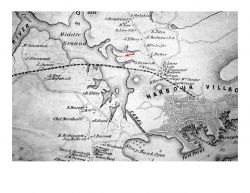loading 
Fitz Henry Lane
HISTORICAL ARCHIVE • CATALOGUE RAISONNÉ • EDUCATIONAL RESOURCE
An online project under the direction of the CAPE ANN MUSEUM
An online project under the direction of the CAPE ANN MUSEUM
Catalog entry
inv. 26
Looking up Squam River from Done Fudging
1850s Oil on canvas 12 1/2 x 20 3/4 in. (31.8 x 52.7 cm) No inscription found
|
Related Work in the Catalog
Supplementary Images
Provenance (Information known to date; research ongoing.)
the Artist, Gloucester, Mass.
William Parsons II, 61 Middle Street, Gloucester, Mass.
Anette Parsons Stanley and John L. Stanley, Gloucester, Mass.
William Parsons Stanley and Marina Pattison Stanley, Gloucester, Mass.
Jean Stanley Dise
Cape Ann Museum, Gloucester, Mass., 1964
Exhibition History
No known exhibitions.Published References
Wilmerding, John. Fitz Hugh Lane. New York: Praeger, 1971.
Moses, Michael A. "Mary B. Mellen and Fitz Hugh Lane." Antiques Magazine Vol. CXL, No. 5 (November 1991)., p. 829. ⇒ includes  text
text
Worley, Sharon. "Fitz Hugh Lane and the Legacy of the Codfish Aristocracy." Historical Journal of Massachusetts 32, no. 1 (Winter 2004)., p. 80. ⇒ includes  text
text
Wilmerding, John. Fitz Henry Lane. Gloucester, MA: Cape Ann Historical Association, 2005. Reprint of Fitz Hugh Lane, by John Wilmerding. New York: Praeger, 1971. Includes new information regarding the artist's name., ill. 52.
Craig, James. Fitz H. Lane: An Artist's Voyage through Nineteenth-Century America. Charleston, SC: The History Press, 2006., pl. 26.
Rodgers, Josephine. "Fitz H. Lane's Enduring Legacy along the
New England Coastline." Yale University Art Gallery Bulletin (Yale University Art Gallery) (2022-2023)., p. 13. ⇒ includes  text
text

Commentary
This exquisite painting is quite small, yet it captures an expansive landscape in great detail. The view is looking west up the Annisquam River from a spot referred to as "Done Fudging." The present-day site is the Grant Circle traffic rotary on Massachusetts Route 128, just as one comes off the bridge over the Annisquam River and onto Cape Ann.
"Fudging" is a local term specific to river craft and refers to the upstream poling that was often necessary in the narrow river because of unfavorable wind or tidal flow. Lane drew and painted a number of pictures from this spot, where one could stop the laborious poling and be "done fudging." It must have been relatively easy for him to get here from the harbor by carriage—one of his early residences was only a half mile or so away. In contrast to the constant bustle of the harbor, Done Fudging was a peaceful and verdant place.
The upland field, rocks, and shrubs in the foreground, painted in sharp detail, give onto the flat monochrome of the salt marshes and the silvery-green hills of Wolf Island (on the right) and those behind Little River (on the left). Though this is unusual for Lane, the landscape is almost empty except for the small sloop pulled up on the shore, the ruin of a gundalow (used for hauling salt hay, and propelled by poling) on the right edge, and the small, distant sail. Otherwise, this is a tonal study of a beautiful Indian-summer day in late September or early October when the marshes have started turning gold, and trees and shrubs are showing a hint of red.
For all its seeming simplicity, Looking up Squam River from Done Fudging is a strong composition. Lane leads the eye in from the lower left, following the stones diagonally to the gundalow before returning to the left and following the river course and marsh edge. The direction then reverses to the right and takes the viewer's eye onto the brightly lit river, to the sail in the distance, and on around the corner of the land form. This Z-shaped composition, commonly used by Lane, leads the eye effortlessly through the picture and up the river, creating a balanced and open-ended feeling of space and distance.
There are relatively few Lanes with so little anecdotal detail; one wonders if this painting might have been influenced by the salt-marsh paintings of Martin Johnson Heade. Heade painted in the marshes north of Gloucester in Newbury and Newburyport from the late 1850s through the 1860s. His paintings are often devoid of human activity, and they lead the viewer through the deep space of the salt marsh by following the meanderings of the channels and hay stacks that recede into the distance.
The drawing for this painting is Westward View from near East End of Railroad Bridge, Mid 1850s (inv. 118). It is gridded vertically for transfer onto a canvas. Note where Lane, in order to complete the symmetry of the grid, extended the left edge of the painting beyond the point where the drawing stopped. Lane did a number of other paintings from this spot, most notably New England Inlet with Self-Portrait, 1848 (inv. 77). That painting shows the artist drawing, with his crutches beside him, and is one of only a few paintings we know of with an apparent self-portrait. Another emphasis of that painting is the railroad trestle on the left with a train shown heading into Gloucester. (The railroad had newly arrived to Gloucester in 1848.) This painting, by contrast, shows the embankment of the railroad on the left but no train to disturb the tranquility of the setting.
– Sam Holdsworth